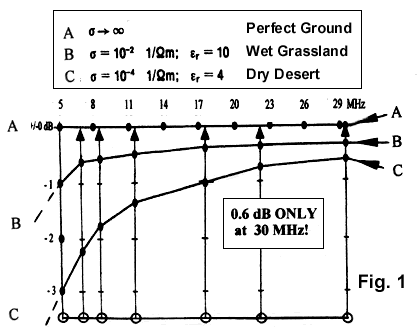
Sommer Antennas: Antenna Ground

 [ORDERING]
[ORDERING] [COMMENTS]
[COMMENTS] [REVIEWS]
[REVIEWS] [BACKGROUND]
[BACKGROUND] Sommer Antennas: Antenna Ground  |
 [ORDERING] [ORDERING] [COMMENTS] [COMMENTS] [REVIEWS] [REVIEWS] [BACKGROUND] [BACKGROUND] |
 |
FIG. 1 shows the relative gain (loss) of an antenna (e.g., dipole or beam), under varying ground conditions, through the frequency range of 5-30MHz: A represents the curve under perfect ground conditions, B under average ground conditions (i.e., wet grassland), and C under poor ground conditions (dry desert).
|
|
Note that the influence of ground conditions diminishes rapidly as the frequency increases. While a good ground system can substantially improve performance at the lower frequencies, at 30MHz there is very little difference in gain between a dipole with a perfect ground and one with poor ground. For example, at 5MHz a receiving or transmitting signal that is S9 +10 dB over perfect ground becomes S9 +7 dB over extremely poor ground (a 3 dB drop); but at 30MHz, a signal that is S9 +10 dB over perfect ground, drops to S9 +9.4 dB over extremely poor ground (a drop of just .6 dB!). Conclusion: The influence of ground conductivity becomes less important at 14MHz and higher (1.2 dB difference or less).
|
|
_________________________________
Information from "Neues von Rohde und Schwarz" Oktober/Nov. 1973.
 Sommer Antennas
Sommer Antennas 
P.O. Box 710
Geneva, FL 32732
Phone: (407) 349-9114 | Fax: (407) 349-2485